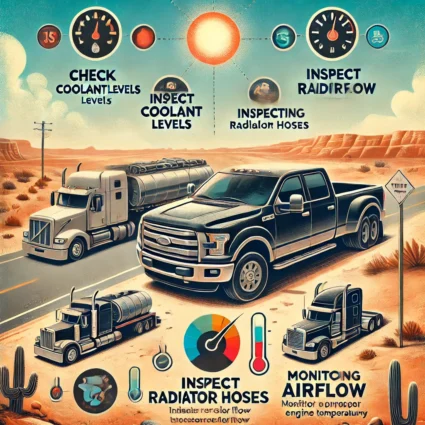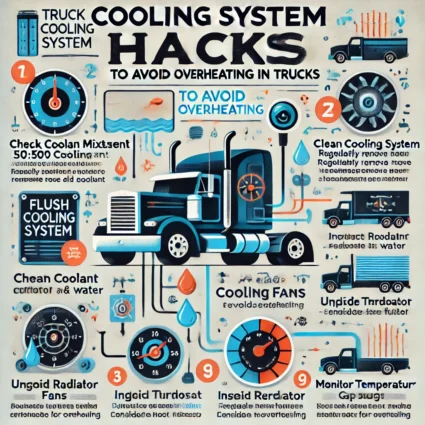
Cooling System Hacks to Avoid Overheating in Trucks
When you’re on the road, few things are more frustrating than seeing the temperature gauge inch toward the red zone.
Overheating can sideline a truck fast, putting both time and money at risk so what can you do to Avoid Overheating in Trucks.
Whether you’re hauling heavy loads in a semi or using a pickup for work or recreation, a reliable cooling system is essential.
Fortunately, there are some practical steps you can take to avoid overheating in trucks issues before they start.
This article covers straightforward cooling hacks for truck owners that are effective, low-cost, and easy to implement for avoid overheating in trucks.
1. Understand How Your Truck’s Cooling System Works
At its core, a truck’s cooling system manages engine heat through a network of components working together. Coolant flows through the engine, absorbing heat generated from combustion, before passing through a radiator where it releases that heat to the outside air.
Here’s a breakdown of the primary components for avoid overheating in trucks:
- Radiator: A network of tubes and fins that disperses heat from the coolant.
- Water Pump: Circulates coolant through the engine and radiator.
- Thermostat: A valve that controls the coolant flow based on engine temperature.
- Cooling Fans: These draw cooler air into the radiator, assisting in heat transfer.
- Coolant (or Antifreeze): A fluid blend (usually water and ethylene glycol) that absorbs and dissipates heat.
For trucks, cooling systems are designed to withstand high temperatures and loads. However, regular maintenance and smart hacks can further improve efficiency and reliability and give you more time in to avoid overheating in trucks.

| Cooling System Hack | Explanation | Benefit |
|---|
| Check and Maintain Coolant Mixture | Use a 50:50 coolant-to-water ratio and adjust for climate conditions. | Ensures efficient heat absorption and transfer. |
| Flush the Cooling System | Regularly remove old coolant and deposits from the radiator. | Prevents clogging and maintains optimal flow. |
| Clean the Radiator Exterior | Remove dirt, bugs, and debris from the radiator with a low-pressure hose. | Improves airflow for better cooling efficiency. |
| Inspect and Replace Thermostat | Check thermostat for wear; replace if necessary to maintain proper coolant flow. | Prevents overheating by regulating engine temp. |
| Upgrade Cooling Fans | Consider electric or dual fans, or check fan clutch for wear. | Enhances cooling power, especially under heavy load. |
| Use a Radiator Additive | Additives lower coolant surface tension for better heat transfer. | Reduces overall engine temperature. |
| Practice Smart Driving Habits | Downshift on hills, reduce A/C usage, and avoid long idling. | Minimizes heat build-up during tough conditions. |
| Install High-Quality Radiator Cap | Use a cap with the correct pressure rating to maintain system pressure. | Raises coolant boiling point, preventing boil-over. |
| Monitor Temperature Gauge | Keep an eye on the gauge, and take action if temperature rises unexpectedly. | Provides early warning to prevent serious damage. |
2. Hack #1: Check and Maintain the Right Coolant Mixture
Coolant is one of the most important elements of the cooling system. Trucks typically require a 50:50 mix of coolant and water, but this may vary depending on the climate and load requirements when it comes to avoid overheating in trucks.
- Testing Coolant: Use a hydrometer to check the coolant mixture in your truck. This tool measures the freezing and boiling points of the coolant to ensure it’s within the safe range.
- Adjusting Coolant Ratio: In colder climates, increase the percentage of coolant to prevent freezing. In warmer climates, maintain a balanced 50:50 ratio for optimal boiling protection.
- Keep Coolant Levels High: Low coolant levels lead to poor heat absorption, which causes engines to overheat. Regularly check levels and refill as necessary.
3. Hack #2: Flush the Cooling System Regularly
Flushing the cooling system is one of the best ways to keep your truck running cool.
Over time, debris, rust, and mineral buildup can clog the radiator and reduce coolant flow. A cooling system flush removes these impurities, restoring efficiency.
- Frequency: Most experts recommend flushing the system every 30,000 miles for trucks, but check your owner’s manual for specific recommendations.
- DIY Flush: If you’re comfortable with basic maintenance, you can flush the cooling system yourself. Just drain the old coolant, run distilled water through the system to clear out residues, and refill with fresh coolant.
- Professional Flush: For a deeper clean, consider a professional flush. Professionals use chemicals designed to break down stubborn deposits that may be hard to reach on your own.
4. Hack #3: Keep Your Radiator Clean and Free of Debris
Truck radiators are exposed to all kinds of dirt, insects, and debris, especially if you’re driving off-road or in dusty conditions. This can restrict airflow, reducing the radiator’s cooling efficiency.
- Regular Cleaning: Periodically clean the radiator’s exterior with a low-pressure hose to remove dirt, bugs, and other contaminants. Be gentle; high-pressure water could damage the radiator fins.
- Fin Straightening Tool: Bent radiator fins can also restrict airflow. Use a fin comb or fin straightening tool to align any bent fins, improving airflow and cooling efficiency.
- Install a Screen: Adding a screen in front of your radiator can help protect it from large debris without limiting airflow.
5. Hack #4: Check the Thermostat for Signs of Wear
The thermostat is a small but crucial component. It regulates coolant flow, allowing the engine to reach and maintain the ideal operating temperature.
If it gets stuck or fails, it can prevent coolant from circulating, leading to overheating and you want to avoid overheating in trucks.
- Signs of a Faulty Thermostat: An overheating engine, fluctuating temperature readings, or sluggish warm-ups are all indicators of a potential thermostat issue.
- Thermostat Replacement: Replacing a faulty thermostat is generally inexpensive and can often be done at home with basic tools. Consider replacing it every 50,000 miles as preventive maintenance, especially in high-stress vehicles like trucks.
6. Hack #5: Upgrade Your Cooling Fans
While factory cooling fans are typically sufficient for regular use, an aftermarket fan upgrade can significantly boost your truck’s cooling capacity.
This is especially useful if you drive in high-heat environments, tow heavy loads, or frequently drive uphill.
- Electric Fans: These are more efficient than traditional mechanical fans and can be triggered to start at a certain temperature, offering precision cooling when it’s needed most.
- Dual Fans: For heavy-duty trucks, consider a dual-fan setup, which provides double the airflow and is ideal for intense heat management.
- Fan Clutch Check: If your truck has a fan clutch, inspect it for wear. A slipping or broken fan clutch reduces fan speed and compromises cooling, so replace it if it’s worn out.
7. Hack #6: Use a Radiator Additive for Extra Cooling Power
Radiator additives can help your cooling system run more efficiently by reducing the coolant’s surface tension, allowing it to make better contact with metal surfaces inside the engine and avoid overheating in trucks.
This promotes faster heat transfer and keeps temperatures in check.
- Choosing an Additive: Look for additives designed for high-performance and heavy-duty engines. Many are compatible with all types of antifreeze.
- Applying the Additive: Follow the instructions on the additive bottle. Most additives can be poured directly into the radiator, but be cautious of mixing different types, as some may not be compatible with your coolant.
8. Hack #7: Drive Smart to Avoid Overheating
Driving habits have a huge impact on engine temperature. Here are some ways to stay cool while driving, especially in hot weather or challenging conditions:
- Downshift on Hills: If you’re pulling a heavy load uphill, downshift to reduce the strain on your engine and prevent it from overheating.
- Use the A/C Sparingly: Running the air conditioning adds extra load to the engine. If you notice the temperature creeping up, turn off the A/C until it stabilizes.
- Idle Mindfully: Avoid idling for long periods, as this can cause heat to build up without sufficient airflow. If you’re stopped for an extended time, consider turning off the engine.
9. Hack #8: Install a High-Quality Radiator Cap
A high-quality radiator cap can help your cooling system maintain the correct pressure. The cap increases the boiling point of the coolant, making it better able to withstand extreme heat for avoid overheating in trucks.
- Checking Cap Condition: A faulty radiator cap can lead to coolant loss, reduced pressure, and overheating. Check it regularly for signs of wear, such as rust, cracks, or a loose seal.
- Upgrade Options: Some aftermarket caps allow for adjustable pressure settings, ideal for high-performance or heavy-duty trucks. Make sure the cap is rated for your specific vehicle before upgrading.
10. Hack #9: Keep an Eye on the Temperature Gauge
Finally, always keep an eye on your truck’s temperature gauge. Noticing changes early can prevent bigger issues later.
- Warning Signs: If the gauge suddenly rises, find a safe place to pull over, turn off the engine, and let it cool. Check coolant levels and inspect for leaks once it’s safe to do so.
- Temporary Measures: If your engine overheats and you’re in a pinch, turn the heater on full blast. This redirects heat away from the engine into the cab, providing temporary relief.
Final Thoughts
Keeping your truck’s cooling system in top shape is essential to avoiding overheating issues and costly repairs.
By implementing these simple cooling system hacks, you’ll keep your truck running smoothly even in the hottest conditions or under the heaviest loads.
Avoid overheating in trucks, from maintaining coolant levels to upgrading fans and adjusting driving habits, contributes to a more efficient and durable cooling system.
Don’t let overheating put the brakes on your plans—stay proactive, stay cool, and keep your truck on the road.
We hope you found this information on avoid overheating in trucks useful in your driving habits.